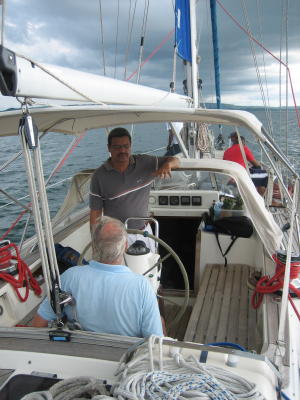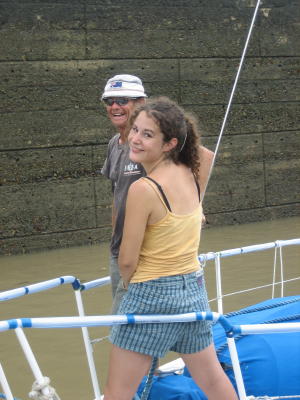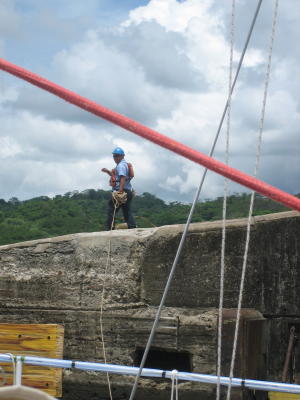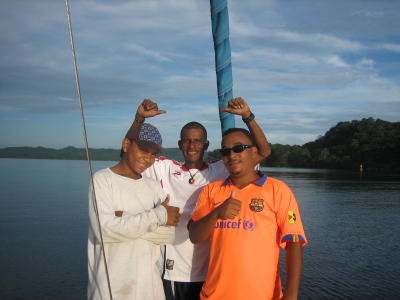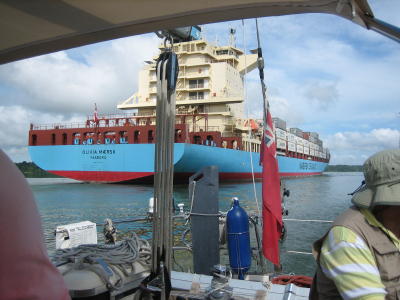The Panama Canal and photos

|
I was having lunch alone – Mags was busy on the boat preparing a large
English shepherds’ pie for Panamanian line handlers. We were due off at 1800 but I had
brought the hand held VHF radio to the restaurant “just in case”. It burst into life with a list of
traffic. I paid
attention.
“JJ Moon, JJ Moon. Cristobal Signal Station.” “Cristobal Signal, JJ Moon.” “JJ Moon: pilot on board, at the Flats, 1600. Pilot on board 1600.” “Understood. Pilot on board 1600. JJ Moon standing by, channel 12.” Oh no. We had two hours less than we thought. The impellers had been delivered and the line handlers were due at 1500 but there was no sign of the wrapped motor tyre fenders and Carole from our neighbouring cat, who had been so friendly and helpful, wanted Mags for last minute computer advice.
It was a rush but we got it together and
motored off the dock at 1550 making for the yacht anchorage, “the Flats”. The pilot cutter came alongside with
Roy, our pilot /adviser and we settled down to wait for the big ship that was to
share the locks with three small craft.
The concept behind the design of the canal is interesting. Unlike Suez, a sea level canal, the American army engineers dammed three rivers and created a lake thirty miles wide and studded with islands, with its water level about 85 feet above sea level. At each end there are three locks filled from the lake reservoir. Each chamber is 1000ft long by 100ft wide and the water rises and falls 30ft in about 10 minutes. That is a lot of water to come boiling up from holes in the chamber floors and there is a good deal of turbulence causing much fear and despondency in prospect. However, I get the impression that the professionals involved at all levels are so experienced that there are rarely any accidents leading to serious damage.
We and our friends Y-Not were rafted up either side of a sports fishing boat, about the same length as us but very swift and swish. The weather closed in and by the time we were in the first chamber it was dusk and the rain was pelting down. Everybody on the yachts was drenched but as the lights came on we could peer through the large tinted windows alongside. Lounging on the saloon sofas were two lovely young ladies in spangled cocktail dresses taking their evening drinkies and nibbles. We were reminded that there is “messing about in boats” and there is “yachtin”.
Helped by the
cruiser’s big engines and the practised skill of all those on board, the lock
side line handlers pulled the three boats through the chambers smoothly and
without fuss and we were up on the lake. We tied to a buoy a mile further on in a
beautifully picturesque spot.
Up at 0600 for a
fine breakfast to which the lads gave full justice and our new adviser was
aboard at 0715. A most amiable man,
rather garrulous and when push came to shove, as it did at the entrance to the
locks, not perhaps as commanding and decisive as
The channel winds
across the lake between the islands which are covered with lush green
vegetation. The American army used
to use this country for jungle training.
Five hours of tranquil motoring with only the odd large ship at unusually
close quarters to disturb our peace and equanimity. At the end of the lake the channel
passes through a rocky cutting, a little vestige of the
The transit was fascinating, not at all how we imagined it beforehand but probably the most interesting cruising experience we have had so far.
|

